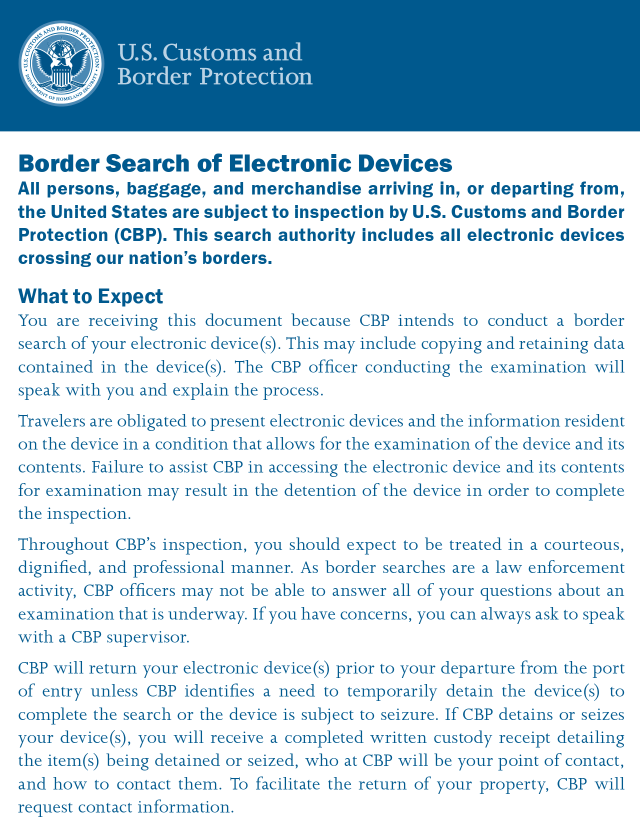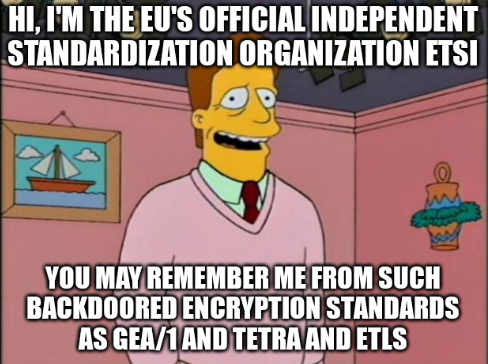If you use systemd's DHCP client, since version 235 you can set Anonymize=true in your network config to stop sending unique identifiers as per RFC 7844 Anonymity Profiles for DHCP Clients. (Don't forget to also set MACAddressPolicy=random.)
They only do that if you are a threat.
Lmao. Even CBP does not claim that. On the contrary, they say (and courts have so far agreed) that they can perform these types of border searches without any probable cause, and even without reasonable suspicion (a weaker legal standard than probable cause).
In practice they routinely do it to people who are friends with someone (or recently interacted with someone on social media) who they think could be a threat, as well as to people who have a name similar to someone else they're interested in for whatever reason, or if the CBP officer just feels like it - often because of what the person looks like.
It's nice for you that you feel confident that you won't be subjected to this kind of thing, but you shouldn't assume OP and other people don't need to be prepared for it.
If they ask for a device's password and you decline to give it to them, they will "detain" the device. See this comment for some links on the subject.
I’m pretty sure that immigration in the US can just confiscate your devices if you are not a citizen .
CBP can and does "detain" travelers' devices at (or near) the border, without a warrant or any stated cause, even if they are US citizens.
Here is part of the notice they give people when they do:

Or just removing my biometrics?
Ultimately you shouldn't cross the US border carrying devices or encrypted data which you aren't prepared to unlock for DHS/CBP, unless you're willing to lose the hardware and/or be denied entry if/when you refuse to comply.
If they decide to, you'll be handed this: "You are receiving this document because CBP intends to conduct a border search of your electronic device(s). This may include copying and retaining data contained in the device(s). [...] Failure to assist CBP in accessing the electronic device and its contents for examination may result in the detention of the device in order to complete the inspection."
Device searches were happening a few hundred times each month circa 2009 (the most recent data i could find in a quick search) but, given other CBP trends, presumably they've become more frequent since then.
In 2016 they began asking some visa applicants for social media usernames, and then expanded it to most applicants in 2019, and the new administration has continued that policy. I haven't found any numbers about how often they actually deny people entry for failing to disclose a social media account.
In 2017 they proposed adding the authority to also demand social media passwords but at least that doesn't appear to have been implemented.
adding all compiled file types including .pyc to .gitignore would fix it
But in this case they didn't accidentally put the token in git; the place where they forgot to put *.pyc was .dockerignore.
It seems to me that switching SIMs provides little privacy benefit, because carriers, data brokers, and the adversaries of privacy-desiring people whom they share data with are obviously able to correlate IMEIs (phones) with IMSIs (SIMs).
What kind of specific privacy threats do you think are mitigated by using different SIMs in the same phone (especially the common practice of using an "anonymous" SIM in a phone where you've previously used a SIM linked to your name)?
At my workplace, we use the string @nocommit to designate code that shouldn’t be checked in
That approach seems useful but it wouldn't have prevented the PyPI incident OP links to: the access token was temporarily entered in a .py python source file, but it was not committed to git. The leak was via .pyc compiled python files which made it into a published docker build.
this isn’t remotely how this meme is used lol

wikipedia articles about him have been deleted twice:
python -c 'print((61966753*385408813*916167677<<2).to_bytes(11).decode())'
how?
$ python
>>> b"Hello World".hex()
'48656c6c6f20576f726c64'
>>> 0x48656c6c6f20576f726c64
87521618088882533792115812
$ factor 87521618088882533792115812
87521618088882533792115812: 2 2 61966753 385408813 916167677





democracy dies in dark mode